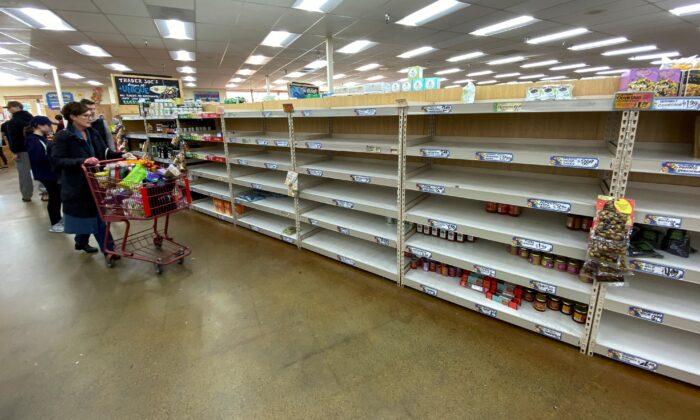Many shelves lay empty at grocery stores across the nation as buyers stocked up in preparation to hunker down amid the coronavirus outbreak. Several major grocery chains cut hours, and many stores rationed some essentials to abate restocking woes.
The items most often reported as lacking included toilet paper, hand sanitizer, paper towels, and bottled water. Some customers also reported that milk, eggs, pasta, and flour were out of stock.
President Donald Trump announced a national emergency on March 13 while the House of Representatives passed an aid package to fund testing for the virus, paid sick leave, and additional food stamps.
States and localities have been declaring their own states of emergency and adopting protective measures such as banning large gatherings and encouraging people to avoid crowds.
Paradoxically, the shopping fever led to long lines and packed stores, creating exactly the crowds authorities have called for avoiding.
“It’s crazy. People have gone crazy,” said Alexis Coppol, a resident of the District of Columbia who was shopping at the bulk grocery store Costco. “I mean, I’m not too worried, but if we get put on a lockdown, I want to make sure I have food.”
Grocers have scrambled to control the crowds and restock.
Walmart announced on March 14 it will limit opening hours to 6 a.m. to 11 p.m. starting March 15 until further notice.
Its chief executive, Doug McMillon, said at a news conference with Trump on March 13 that the retailer was having trouble keeping up with demand for products such as hand sanitizer, cleaning supplies, and paper goods.
“Hand sanitizer is going to be very difficult to have 100 percent in stock for some time,” McMillon said. “We’re still replenishing it ... but as soon as it hits the stores, it’s going. The same thing is true for the other categories I mentioned.”
Pharmacy chain Walgreens and supermarket chain Kroger instituted purchase limits to stabilize their inventories.
Kroger, the second-largest grocery store operator, limited the number of cold, flu, and sanitary products per visit, while Walgreens said it was limiting disinfectant wipes and cleaners, face masks, hand sanitizers, thermometers, and gloves to four per customer.






Friends Read Free